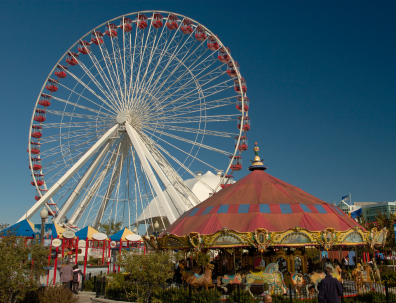
Navy Pier is a 3,000 foot long pier, and was a part of the plan of the City of Chicago, designed by city planner and architect Daniel Burnham and Associates. The pier was constructed in 1916 and cost an estimated $4.5 million to complete. The structure was originally intended to be used for cargo facility purposes for lake freighters, and there were warehouses built up and down the pier. It was also designed to be a docking space for passenger steamers and due to the location was ideal for public gatherings because of the cooler temperatures in an era that did not have air conditioning.
Even while the pier was being constructed, the introduction of cars and trucks was going to have a direct impact on the usability of the pier. The pier became much more popular as a public gathering place then it ever did at being used for the purpose for which it was designed. During World War II, the pier was used for Navy training, and at the time approximately 600,000 sailors and 15,000 pilots used the pier for training purposes. For this reason, the name was changed from Chicago Municipal Pier to Navy Pier.
Once the war concluded, Navy Pier fell into the hands of the University of Illinois. During this time, the facility was used as a classroom for training returning veterans in a two-year undergraduate program. However, in 1965 the University of Chicago moved to the Chicago Circle campus, and the pier was no longer used.
From the years of 1965 through 1989, the pier area was considered a public eyesore. Nobody and no agency in or around Chicago wanted to pour any funds into the structure. In 1976, the pier began to serve its third function, being used as a public gathering place. The east buildings were reopened as exhibit halls and special events and festivals began to draw people to the area once again. From 1979 through 1987, the US Submarine USS Silversides was docked at the pier.
In 1989, the Metropolitan Pier and Exposition Authority took over the pier, and major renovations and construction began in the early 1990's. The pier was rebuilt at a cost of $200 million, and the pier contained kiosks, restaurants, a ballroom, shops, a concert stage, convention hall and a ballroom. Focal points of the restoration include a 150 ft. tall Ferris wheel, an IMAX Theater, the Chicago Children's Museum, Chicago Shakespeare Theater, the Smith Museum of Stained Glass Windows and a Bob Newhart statue which sits at the entrance to Navy Pier.
If one structure could be chosen to best represent the history and culture of Chicago, it would be Navy Pier. The 79 year old lakefront landmark continues to experience growth and improvements, making it a work in progress. Every year there are more festivals and attractions added to the pier, which is the reason why an average of eight million people per year visit Navy Pier.